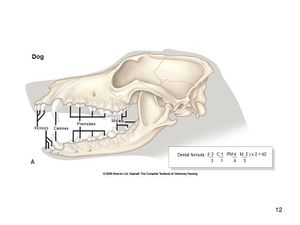Difference between revisions of "Dental Formula - Dog"
Ggaitskell (talk | contribs) |
|||
| Line 30: | Line 30: | ||
Eruption times differ between breeds so it is difficult to age dogs by their teeth. | Eruption times differ between breeds so it is difficult to age dogs by their teeth. | ||
| + | |||
| + | {{Template:Learning | ||
| + | |OVAM = [http://www.onlineveterinaryanatomy.net/content/canine-dentition Image - Canine Dentition] | ||
| + | }} | ||
| + | |||
{{OpenPages}} | {{OpenPages}} | ||
[[Category:Teeth - Anatomy & Physiology]] | [[Category:Teeth - Anatomy & Physiology]] | ||
Revision as of 06:09, 9 July 2014
Overview

Dogs are toothless at birth. Their deciduous teeth are complete and functional within 2 months of birth in most breeds. Permanent teeth are complete and funtional by the end of the 7th month.
The formula for deciduous teeth: 2 (i3/3 c1/1 p3/3)
The formula for permanent teeth: 2 (I3/3 C1/1 P4/4 M2/3)
Canine teeth
The canine teeth are large, curved and laterally compressed. Their root is longer than their crown. They have a single root.
Molars
The molars are broader than the premolars. The large flat surface is used for grinding.
Incisors
The incisors are tricuspid in the upper jaw and bicuspid in lower jaw. They have a single root.
Premolars
The premolars are irregular and closely-spaced. They are more complex and larger caudally.
Breed Differences
Eruption times differ between breeds so it is difficult to age dogs by their teeth.
| Dental Formula - Dog Learning Resources | |
|---|---|
Anatomy Museum Resources |
Image - Canine Dentition |
Error in widget FBRecommend: unable to write file /var/www/wikivet.net/extensions/Widgets/compiled_templates/wrt694cd1457d6ef8_80546101 Error in widget google+: unable to write file /var/www/wikivet.net/extensions/Widgets/compiled_templates/wrt694cd1458b1466_90226553 Error in widget TwitterTweet: unable to write file /var/www/wikivet.net/extensions/Widgets/compiled_templates/wrt694cd14595c939_48646458
|
| WikiVet® Introduction - Help WikiVet - Report a Problem |